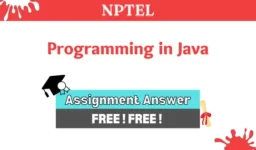Dear student, are you looking for some help in problem solving through programming in C NPTEL week 10 assignment? So, here in this article, we have provided C language assignment answers hints.
NPTEL Problem Solving Through Programming In C Week 10 Assignment Answers
Q1. What is the output of the C program given below?
#include <stdio.h>
int main(){
char str[]="NPTEL";
char str2[ ] = {'P', 'R'. 'O'. 'G'. 'R'. 'A', 'M', 'M', 'T'. 'N'. 'G'};
int n1 = sizeof(str1)/sizeof(str1[0]):
int n2 = sizeof(str2)/sizeof(str2[0]):
printf("n1 = %d. n2 = %d", nl, n2);
return 0;
}a. n1 = 9, n2 = 10
b. n1 = 6, n2 = 11
c. n1 = 7, n2 = 12
d. n1 = 6, n2 = 10
Answer: Option B
1100+ Students are taking advantage of instant notification, Join us on telegram.
Q2. Bisection method is used to find
a. Derivative of a function at a given point
b. Numerical integration of a function within a range
c. The root of a function
d. None of the above
Answer: Option C
Q3. In…………………………………….. the search starts at the beginning of the list and checks every element in the list.
a. Linear search
b. Binary search
c. Hash search
d. Binary tree search
Answer: Option A
Q4. What is the worst-case complexity of bubble sort?
a. O(N log N)
b. O(log N)
c. O(N)
d. O(N2)
Answer: Option D

